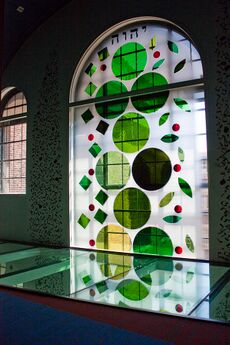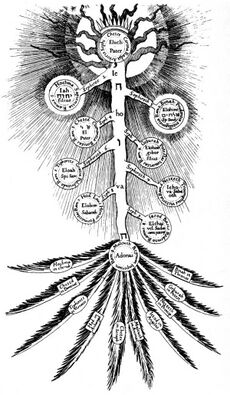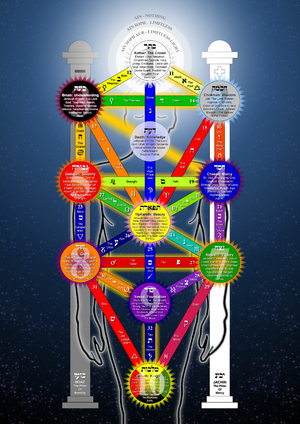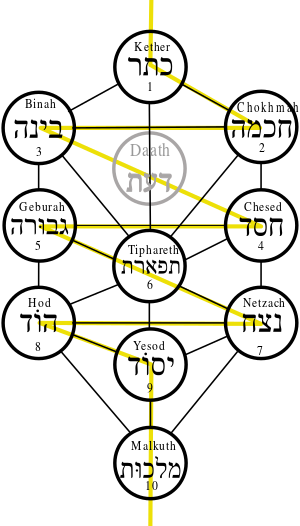شجرة الحياة (قباله)
| جزء من سلسلة مقالات عن |
| القبالة |
|---|
 |
قالب:Thelema The tree of life (بالعبرية: עֵץ חַיִּים or بالعبرية: אִילָן) is a diagram used in Rabbinical Judaism in kabbalah and other mystical traditions derived from it.[1] It is usually referred to as the "kabbalistic tree of life" to distinguish it from the tree of life that appears alongside the tree of the knowledge of good and evil in the Genesis creation narrative and well as the archetypal tree of life found in many cultures.[1][2]
Simo Parpola asserted that the concept of a tree of life with different spheres encompassing aspects of reality traces its origins back to the Neo-Assyrian Empire in the ninth century BCE.[1][2] The Assyrians assigned moral values and specific numbers to Mesopotamian deities similar to those used in Kabbalah and claims that the state tied these to sacred tree images as a model of the king parallel to the idea of Adam Kadmon.[1][2] However, J. H. Chajes states that the ilan should be regarded as primarily indebted to the Porphyrian tree and maps of the celestial spheres rather than to any speculative ancient sources, Assyrian or otherwise.[3][4]
Kabbalah's begins date to the Middle Ages, originating in the Bahir and the Zohar.[5] Although the earliest extant Hebrew kabbalistic manuscripts dating to the late 13th century contain diagrams, including one labelled "Tree of Wisdom," the now-iconic tree of life emerged during the fourteenth century.[4][6]
The iconic representation first appeared in print on the cover of the Latin translation of Gates of Light in the year 1516.[[#cite_note-FOOTNOTELow2015[[تصنيف:مقالات_بالمعرفة_بحاجة_لذكر_رقم_الصفحة_بالمصدر_from_October_2023]][[Category:Articles_with_invalid_date_parameter_in_template]]<sup_class="noprint_Inline-Template_"_style="white-space:nowrap;">[<i>[[المعرفة:Citing_sources|<span_title="هذه_المقولة_تحتاج_مرجع_إلى_صفحة_محددة_أو_نطاق_من_الصفحات_تظهر_فيه_المقولة'"`UNIQ--nowiki-00000016-QINU`"'_(October_2023)">صفحة مطلوبة</span>]]</i>]</sup>-7|[7]]] Scholars have traced the origin of the art in the Porta Lucis cover to Johann Reuchlin.[8]
Description
The tree of life usually consists of 10 or 11 nodes symbolizing different archetypes and 22 paths connecting the nodes.[9] The nodes are often arranged into three columns to represent that they belong to a common category.[9]
In kabbalah, the nodes are called sefirot.[9] They are usually represented as spheres and the paths (بالعبرية: צִנּוֹר) are usually represented as lines.[9] The nodes usually represent encompassing aspects of existence, God, or the human psyche.[9][10][11] The paths usually represent the relationship between the concepts ascribed to the spheres or a symbolic description of the requirements to go from one sphere to another.[9][11] The columns are usually symbolized as pillars.[9] These usually represent different kinds of moral values, electric charges, or types of ceremonial magic.[9][[#cite_note-FOOTNOTELow2015[[تصنيف:مقالات_بالمعرفة_بحاجة_لذكر_رقم_الصفحة_بالمصدر_from_October_2023]][[Category:Articles_with_invalid_date_parameter_in_template]]<sup_class="noprint_Inline-Template_"_style="white-space:nowrap;">[<i>[[المعرفة:Citing_sources|<span_title="هذه_المقولة_تحتاج_مرجع_إلى_صفحة_محددة_أو_نطاق_من_الصفحات_تظهر_فيه_المقولة'"`UNIQ--nowiki-00000024-QINU`"'_(October_2023)">صفحة مطلوبة</span>]]</i>]</sup>-12|[12]]]
The traditional list of sefirot is:
1. Keter "Crown"
2. Chokhmah "Wisdom"
3. Binah "Understanding"
4. Hesed "Compassion"
5. Gevurah "Discernment"
6. Tifereth "Beauty"
7. Netzach "Endurance, Victory"
8. Hod "Splendour"
9. Yesod "Foundation"
10.Malkuth "Kingdom"
An eleventh sefirah, Da'at, appears in some ilanot at the intersection of the ṣinnoroth between nodes 2-4.
The diagram is also used in Christian Kabbalah, Hermetic Qabalah, and Theosophy.[[#cite_note-FOOTNOTELow2015[[تصنيف:مقالات_بالمعرفة_بحاجة_لذكر_رقم_الصفحة_بالمصدر_from_October_2023]][[Category:Articles_with_invalid_date_parameter_in_template]]<sup_class="noprint_Inline-Template_"_style="white-space:nowrap;">[<i>[[المعرفة:Citing_sources|<span_title="هذه_المقولة_تحتاج_مرجع_إلى_صفحة_محددة_أو_نطاق_من_الصفحات_تظهر_فيه_المقولة'"`UNIQ--nowiki-00000026-QINU`"'_(October_2023)">صفحة مطلوبة</span>]]</i>]</sup>-13|[13]]][2][14] The nodes are also associated with deities, angels, celestial bodies, moral values, single colors or combinations of them, and specific numbers.[10][[#cite_note-FOOTNOTELow2015[[تصنيف:مقالات_بالمعرفة_بحاجة_لذكر_رقم_الصفحة_بالمصدر_from_October_2023]][[Category:Articles_with_invalid_date_parameter_in_template]]<sup_class="noprint_Inline-Template_"_style="white-space:nowrap;">[<i>[[المعرفة:Citing_sources|<span_title="هذه_المقولة_تحتاج_مرجع_إلى_صفحة_محددة_أو_نطاق_من_الصفحات_تظهر_فيه_المقولة'"`UNIQ--nowiki-0000002B-QINU`"'_(October_2023)">صفحة مطلوبة</span>]]</i>]</sup>-15|[15]]]
History
Paolo Riccio's son, Jerome/Hieronymus, actively exchanged letters and shared his father's work with Reuchlin before publication.[16] Thus, in the year 1516, Reuchlin's diagram came to appear on the cover of the Paolo Riccio's Latin translation of Joseph ben Abraham Gikatilla's Gates of Light. The diagram only had 17 paths and, at the time, the concepts of 10 spheres and 22 letters were still distinct in the literature.[17] In 1573, a version sketched by Franciscus Zillettus appeared in Cesare Evoli, De divinis attributis.[18]
This version introduced several innovations that would reappear in later versions: all the spheres were of the same size, the lines became wide paths, the spheres were aligned into 3 distinct columns, Malkuth was connected to three spheres, and astrological symbols for the known celestial bodies were used in conjunction with the Hebrew names to label the spheres. However, it also had only 17 paths, albeit distributed differently. Reuchlin's version was reprinted in Johann Pistorius' compilation of 1587. Finally, several versions from unknown artists introducing 21 and 22 paths appeared in the posthumous print editions of Moses Cordovero's Pardes Rimonim between 1592 and 1609.[19] However, the diagrams with 22 paths lacked consistency with each other and none of them had the 22 letters.[20] Between 1652 and 1654, Athanasius Kircher published his version of the tree in Oedipus Aegyptiacus. Kircher might have designed his diagram in a syncretic attempt to reconcile several distinct ideas. This heavily annotated version, self-termed Sephirotic System, introduced more innovations: abstract concepts, divine names, the 22 Hebrew letters for each path, and new astrological symbols.[21]
Between 1677 and 1684, Christian Knorr von Rosenroth published Kabbala denudata. The first volume concluded with an apparatus featuring five ilanot, or kabbalistic trees, representing various aspects of Lurianic cosmology. Four of these were based on ilanot that had been designed by Jewish kabbalists over the preceding half century; one (his figures 8–12) was designed by Knorr based on his reading of select passages of Naftali Hertz ben Yaakov Elchanan's 1648 Emek ha-melekh.[22]
Consequently, according to contemporary students of Western esotericism (rather than to scholars of Jewish Kabbalah), two versions are now widely circulated: one where Malkuth has 1 path, owing to Reuchlin's original; and another where Malkuth has three paths, owing to several later versions; both having 22 paths in total, corresponding each to a Hebrew letter, owing to Kircher's syncretism.[23] With the resurgence of occultism in the 19th century, many new versions appeared, but without major innovations.[24] In the 20th century, Aleister Crowley might have resurfaced the idea of Da'at as an eleventh hidden sphere between Keter and Tiferet in his book Liber 777, syncretizing the concept with Kircher's symbols and von Rosenroth's diagrams.[25][26]
In the 21st century, enthusiasts might have rushed to attribute these collaborative works spanning centuries and involving several people through complex interactions to single authors. Thus, sometimes, the version where Malkuth has three paths is termed the Tree of Emanation, and the version where Malkuth has one path is termed the Tree of Return.[[#cite_note-FOOTNOTELow2015[[تصنيف:مقالات_بالمعرفة_بحاجة_لذكر_رقم_الصفحة_بالمصدر_from_October_2023]][[Category:Articles_with_invalid_date_parameter_in_template]]<sup_class="noprint_Inline-Template_"_style="white-space:nowrap;">[<i>[[المعرفة:Citing_sources|<span_title="هذه_المقولة_تحتاج_مرجع_إلى_صفحة_محددة_أو_نطاق_من_الصفحات_تظهر_فيه_المقولة'"`UNIQ--nowiki-00000038-QINU`"'_(October_2023)">صفحة مطلوبة</span>]]</i>]</sup>-27|[27]]]
Interpretations
Chabad

According to a Chabad source, the tree of life is to be interpreted in the following way:[28]
The tree represents a series of divine emanations of God's creation itself ex nihilo, the nature of revealed divinity, the human soul, and the spiritual path of ascent by man. In this way, Kabbalists developed the symbol into a full model of reality, using the tree to depict a map of creation.[[#cite_note-FOOTNOTESchneersohn1998[[تصنيف:مقالات_بالمعرفة_بحاجة_لذكر_رقم_الصفحة_بالمصدر_from_October_2023]][[Category:Articles_with_invalid_date_parameter_in_template]]<sup_class="noprint_Inline-Template_"_style="white-space:nowrap;">[<i>[[المعرفة:Citing_sources|<span_title="هذه_المقولة_تحتاج_مرجع_إلى_صفحة_محددة_أو_نطاق_من_الصفحات_تظهر_فيه_المقولة'"`UNIQ--nowiki-0000003B-QINU`"'_(October_2023)">صفحة مطلوبة</span>]]</i>]</sup>-29|[29]]]
The symbolic configuration is made of ten spiritual principles, but eleven can be shown, since Keter and Da'at are interchangeable.[[#cite_note-FOOTNOTESchneersohn1998[[تصنيف:مقالات_بالمعرفة_بحاجة_لذكر_رقم_الصفحة_بالمصدر_from_October_2023]][[Category:Articles_with_invalid_date_parameter_in_template]]<sup_class="noprint_Inline-Template_"_style="white-space:nowrap;">[<i>[[المعرفة:Citing_sources|<span_title="هذه_المقولة_تحتاج_مرجع_إلى_صفحة_محددة_أو_نطاق_من_الصفحات_تظهر_فيه_المقولة'"`UNIQ--nowiki-0000003D-QINU`"'_(October_2023)">صفحة مطلوبة</span>]]</i>]</sup>-30|[30]]]
The tree of the knowledge of good and evil is equivalent to the ten spheres seen from the last sphere of the diagram, Malkuth, and the original tree of life is equivalent to the ten spheres seen from the middle sphere of the diagram, Tiferet.[[#cite_note-FOOTNOTESchneersohn1998[[تصنيف:مقالات_بالمعرفة_بحاجة_لذكر_رقم_الصفحة_بالمصدر_from_October_2023]][[Category:Articles_with_invalid_date_parameter_in_template]]<sup_class="noprint_Inline-Template_"_style="white-space:nowrap;">[<i>[[المعرفة:Citing_sources|<span_title="هذه_المقولة_تحتاج_مرجع_إلى_صفحة_محددة_أو_نطاق_من_الصفحات_تظهر_فيه_المقولة'"`UNIQ--nowiki-0000003F-QINU`"'_(October_2023)">صفحة مطلوبة</span>]]</i>]</sup>-31|[31]]]
Kabbalists believe the tree of life to be a diagrammatic representation of the process by which the universe came into being.[[#cite_note-FOOTNOTESchneersohn1998[[تصنيف:مقالات_بالمعرفة_بحاجة_لذكر_رقم_الصفحة_بالمصدر_from_October_2023]][[Category:Articles_with_invalid_date_parameter_in_template]]<sup_class="noprint_Inline-Template_"_style="white-space:nowrap;">[<i>[[المعرفة:Citing_sources|<span_title="هذه_المقولة_تحتاج_مرجع_إلى_صفحة_محددة_أو_نطاق_من_الصفحات_تظهر_فيه_المقولة'"`UNIQ--nowiki-00000041-QINU`"'_(October_2023)">صفحة مطلوبة</span>]]</i>]</sup>-32|[32]]]
On the tree of life, the beginning of the universe is placed in a space above the first sphere (named "Keter" or "crown" in English). It is not always pictured in reproductions of the tree of life, but is referred to universally as Ohr Ein Sof (بالعبرية: אֵין סוֹף אוֹר).[[#cite_note-FOOTNOTESchneersohn1998[[تصنيف:مقالات_بالمعرفة_بحاجة_لذكر_رقم_الصفحة_بالمصدر_from_October_2023]][[Category:Articles_with_invalid_date_parameter_in_template]]<sup_class="noprint_Inline-Template_"_style="white-space:nowrap;">[<i>[[المعرفة:Citing_sources|<span_title="هذه_المقولة_تحتاج_مرجع_إلى_صفحة_محددة_أو_نطاق_من_الصفحات_تظهر_فيه_المقولة'"`UNIQ--nowiki-00000043-QINU`"'_(October_2023)">صفحة مطلوبة</span>]]</i>]</sup>-33|[33]]]
To Kabbalists, it symbolizes that point beyond which our comprehension of the origins of being can't go. It is considered to be an infinite nothingness out of which the first "thing", usually understood by Kabbalists to be something approximating "energy", exploded to create a universe of multiple things.[[#cite_note-FOOTNOTESchneersohn1998[[تصنيف:مقالات_بالمعرفة_بحاجة_لذكر_رقم_الصفحة_بالمصدر_from_October_2023]][[Category:Articles_with_invalid_date_parameter_in_template]]<sup_class="noprint_Inline-Template_"_style="white-space:nowrap;">[<i>[[المعرفة:Citing_sources|<span_title="هذه_المقولة_تحتاج_مرجع_إلى_صفحة_محددة_أو_نطاق_من_الصفحات_تظهر_فيه_المقولة'"`UNIQ--nowiki-00000045-QINU`"'_(October_2023)">صفحة مطلوبة</span>]]</i>]</sup>-34|[34]]]
Kabbalists also do not envision time and space as preexisting and place them at the next three stages on the tree of life.[[#cite_note-FOOTNOTESchneersohn1998[[تصنيف:مقالات_بالمعرفة_بحاجة_لذكر_رقم_الصفحة_بالمصدر_from_October_2023]][[Category:Articles_with_invalid_date_parameter_in_template]]<sup_class="noprint_Inline-Template_"_style="white-space:nowrap;">[<i>[[المعرفة:Citing_sources|<span_title="هذه_المقولة_تحتاج_مرجع_إلى_صفحة_محددة_أو_نطاق_من_الصفحات_تظهر_فيه_المقولة'"`UNIQ--nowiki-00000047-QINU`"'_(October_2023)">صفحة مطلوبة</span>]]</i>]</sup>-35|[35]]]
First is "Keter", which is thought of as the product of the contraction of "Ein Sof" into a singularity of infinite energy or limitless light. In the Kabbalah, it is the primordial energy out of which all things are created.[[#cite_note-FOOTNOTESchneersohn1998[[تصنيف:مقالات_بالمعرفة_بحاجة_لذكر_رقم_الصفحة_بالمصدر_from_October_2023]][[Category:Articles_with_invalid_date_parameter_in_template]]<sup_class="noprint_Inline-Template_"_style="white-space:nowrap;">[<i>[[المعرفة:Citing_sources|<span_title="هذه_المقولة_تحتاج_مرجع_إلى_صفحة_محددة_أو_نطاق_من_الصفحات_تظهر_فيه_المقولة'"`UNIQ--nowiki-00000049-QINU`"'_(October_2023)">صفحة مطلوبة</span>]]</i>]</sup>-36|[36]]]
The next stage is "Chokhmah" (or "wisdom" in English), which is considered to be a stage at which the infinitely hot and contracted singularity expanded forth into space and time. It is often thought of as pure dynamic energy of an infinite intensity forever propelled forth at a speed faster than light.[[#cite_note-FOOTNOTESchneersohn1998[[تصنيف:مقالات_بالمعرفة_بحاجة_لذكر_رقم_الصفحة_بالمصدر_from_October_2023]][[Category:Articles_with_invalid_date_parameter_in_template]]<sup_class="noprint_Inline-Template_"_style="white-space:nowrap;">[<i>[[المعرفة:Citing_sources|<span_title="هذه_المقولة_تحتاج_مرجع_إلى_صفحة_محددة_أو_نطاق_من_الصفحات_تظهر_فيه_المقولة'"`UNIQ--nowiki-0000004B-QINU`"'_(October_2023)">صفحة مطلوبة</span>]]</i>]</sup>-37|[37]]]
Next comes "Binah" (or "understanding" in English), which is thought of as the primordial feminine energy, the supernal mother of the universe which receives the energy of "Chokhmah", cooling and nourishing it into the multitudinous forms present throughout the whole cosmos. It is also seen as the beginning of time itself.[[#cite_note-FOOTNOTESchneersohn1998[[تصنيف:مقالات_بالمعرفة_بحاجة_لذكر_رقم_الصفحة_بالمصدر_from_October_2023]][[Category:Articles_with_invalid_date_parameter_in_template]]<sup_class="noprint_Inline-Template_"_style="white-space:nowrap;">[<i>[[المعرفة:Citing_sources|<span_title="هذه_المقولة_تحتاج_مرجع_إلى_صفحة_محددة_أو_نطاق_من_الصفحات_تظهر_فيه_المقولة'"`UNIQ--nowiki-0000004D-QINU`"'_(October_2023)">صفحة مطلوبة</span>]]</i>]</sup>-38|[38]]]
Numbers are very important to Kabbalists, and the Hebrew letters of the alphabet also have a numerical value. Each stage of the emanation of the universe on the tree of life is numbered meaningfully from one ("Keter") to ten ("Malkuth"). Each number is thought to express the nature of its sphere.[[#cite_note-FOOTNOTESchneersohn1998[[تصنيف:مقالات_بالمعرفة_بحاجة_لذكر_رقم_الصفحة_بالمصدر_from_October_2023]][[Category:Articles_with_invalid_date_parameter_in_template]]<sup_class="noprint_Inline-Template_"_style="white-space:nowrap;">[<i>[[المعرفة:Citing_sources|<span_title="هذه_المقولة_تحتاج_مرجع_إلى_صفحة_محددة_أو_نطاق_من_الصفحات_تظهر_فيه_المقولة'"`UNIQ--nowiki-0000004F-QINU`"'_(October_2023)">صفحة مطلوبة</span>]]</i>]</sup>-39|[39]]]
The first three spheres, called the "supernal" spheres, are considered to be the primordial energies of the universe. The next stages of evolution on the tree of life are considered to exist beyond a space on the tree, called the "Abyss", between the "supernals" and the other spheres, because their levels of being are so distinct from each other that they appear to exist in two totally different realities. The "supernal" spheres exist on a plane of divine energy. This is why another correspondence for "Binah" is the idea of suffering because the "supernal" maternal energy gives birth to a world that is inherently excluded from that divine union.[[#cite_note-FOOTNOTESchneersohn1998[[تصنيف:مقالات_بالمعرفة_بحاجة_لذكر_رقم_الصفحة_بالمصدر_from_October_2023]][[Category:Articles_with_invalid_date_parameter_in_template]]<sup_class="noprint_Inline-Template_"_style="white-space:nowrap;">[<i>[[المعرفة:Citing_sources|<span_title="هذه_المقولة_تحتاج_مرجع_إلى_صفحة_محددة_أو_نطاق_من_الصفحات_تظهر_فيه_المقولة'"`UNIQ--nowiki-00000051-QINU`"'_(October_2023)">صفحة مطلوبة</span>]]</i>]</sup>-40|[40]]]
After "Binah", the universe gets down to the business of building the materials it will need to fulfill its evolution and be creating new combinations of those materials until it is so dense that, by the stage of "Malkuth", the initial pure limitless energy has solidified into the physical universe.[[#cite_note-FOOTNOTESchneersohn1998[[تصنيف:مقالات_بالمعرفة_بحاجة_لذكر_رقم_الصفحة_بالمصدر_from_October_2023]][[Category:Articles_with_invalid_date_parameter_in_template]]<sup_class="noprint_Inline-Template_"_style="white-space:nowrap;">[<i>[[المعرفة:Citing_sources|<span_title="هذه_المقولة_تحتاج_مرجع_إلى_صفحة_محددة_أو_نطاق_من_الصفحات_تظهر_فيه_المقولة'"`UNIQ--nowiki-00000053-QINU`"'_(October_2023)">صفحة مطلوبة</span>]]</i>]</sup>-41|[41]]]
Since its energies are the basis of all creation, the tree of life can potentially be applied to any area of life, especially the inner world of man, from the subconscious all the way to what Kabbalists call the higher self.[[#cite_note-FOOTNOTESchneersohn1998[[تصنيف:مقالات_بالمعرفة_بحاجة_لذكر_رقم_الصفحة_بالمصدر_from_October_2023]][[Category:Articles_with_invalid_date_parameter_in_template]]<sup_class="noprint_Inline-Template_"_style="white-space:nowrap;">[<i>[[المعرفة:Citing_sources|<span_title="هذه_المقولة_تحتاج_مرجع_إلى_صفحة_محددة_أو_نطاق_من_الصفحات_تظهر_فيه_المقولة'"`UNIQ--nowiki-00000055-QINU`"'_(October_2023)">صفحة مطلوبة</span>]]</i>]</sup>-42|[42]]]
The tree of life does not only speak of the origins of the physical universe out of the unimaginable but also humanity's place in the universe. Since man is invested with a mind, consciousness in the Kabbalah is thought of as the fruit of the physical world, through whom the original infinite energy can experience and express itself as a finite entity.[[#cite_note-FOOTNOTESchneersohn1998[[تصنيف:مقالات_بالمعرفة_بحاجة_لذكر_رقم_الصفحة_بالمصدر_from_October_2023]][[Category:Articles_with_invalid_date_parameter_in_template]]<sup_class="noprint_Inline-Template_"_style="white-space:nowrap;">[<i>[[المعرفة:Citing_sources|<span_title="هذه_المقولة_تحتاج_مرجع_إلى_صفحة_محددة_أو_نطاق_من_الصفحات_تظهر_فيه_المقولة'"`UNIQ--nowiki-00000057-QINU`"'_(October_2023)">صفحة مطلوبة</span>]]</i>]</sup>-43|[43]]]
After the energy of creation has condensed into matter, it is thought to reverse its course back up the tree until it is once again united with its true nature, Keter. Thus the Kabbalist seeks to know himself and the universe as an expression of God and to make the journey of return using the stages charted by the spheres, until he has come to the realization he sought.[[#cite_note-FOOTNOTESchneersohn1998[[تصنيف:مقالات_بالمعرفة_بحاجة_لذكر_رقم_الصفحة_بالمصدر_from_October_2023]][[Category:Articles_with_invalid_date_parameter_in_template]]<sup_class="noprint_Inline-Template_"_style="white-space:nowrap;">[<i>[[المعرفة:Citing_sources|<span_title="هذه_المقولة_تحتاج_مرجع_إلى_صفحة_محددة_أو_نطاق_من_الصفحات_تظهر_فيه_المقولة'"`UNIQ--nowiki-00000059-QINU`"'_(October_2023)">صفحة مطلوبة</span>]]</i>]</sup>-44|[44]]]
Hermetic
In Hermetic Qabalah, the Tree of Life is a fundamental concept and symbol that represents the structure of the universe, as well as the spiritual and metaphysical path to enlightenment. The Tree of Life is often depicted as a diagram composed of ten interconnected spheres (called Sephiroth) and 22 connecting paths, which together form a pattern resembling a tree.
The Sephiroth are the ten spheres on the Tree of Life. Each Sephirah (singular of Sephiroth) represents a different aspect of the Divine, as well as aspects of human consciousness and existence. These are, from top to bottom:[45]
- Keter (Crown)
- Chokmah (Wisdom)
- Binah (Understanding)
- Chesed (Love)
- Gevurah (Strength)
- Tiferet (Beauty)
- Netzach (Eminence)
- Hod (Glory)
- Yesod (Foundation)
- Malkuth (Realm)
Paths
The 22 connecting paths on the Tree of Life represent the connections between the Sephiroth. Each path is associated with a specific Hebrew letter, Tarot card, and a range of meanings and correspondences. Hermetic Qabalists see the cards of the tarot as keys to the Tree of Life. The 22 cards including the 21 Trumps plus the Fool or Zero card are often called the "Major Arcana" or "Greater Mysteries" and are seen as corresponding to the 22 Hebrew letters and the 22 paths of the Tree; the ace to ten in each suit correspond to the ten Sephiroth in the four Qabalistic worlds; and the sixteen court cards relate to the classical elements in the four worlds.[46][47] While the sephiroth describe the nature of divinity, the paths between them describe ways of knowing the Divine.[48]
Path of the flaming sword
The path of the flaming sword (Hebrew: נתיב החרב הבוערת) refers to the flaming sword which God put to guard the Garden of Eden after Adam and Eve were cast out.[49] It is a concept in Kabbalah which represents the order in which the ten sefirot were created. The path emanates from the Ein Sof, the boundless source of divinity, begins at Kether (The Crown) and ends at Malkuth (The Kingdom), where the physical world manifests.[بحاجة لمصدر]
See also
References
- ^ أ ب ت ث Parpola, Simo (1993). "The Assyrian Tree of Life: Tracing the Origins of Jewish Monotheism and Greek Philosophy". Journal of Near Eastern Studies. 52 (3): 161–208. doi:10.1086/373622. JSTOR 545436. S2CID 162212276.
- ^ أ ب ت ث Welch, John Woodland; Parry, Donald W. (2011). The Tree of Life: From Eden to Eternity (in الإنجليزية). Deseret Book.
- ^ Chajes, J. H. (April 2020). "Spheres, Sefirot, and the Imaginal Astronomical Discourse of Classical Kabbalah". Harvard Theological Review. 113 (2): 230–262. doi:10.1017/S0017816020000061.
- ^ أ ب Chajes, Jeffrey Howard (2020). "The Kabbalistic Tree". In Kupfer, Marcia Ann; Cohen, Adam S.; Chajes, Jeffrey Howard (eds.). The Visualization of Knowledge in Medieval and Early Modern Europe (in الإنجليزية). Brepols. ISBN 978-2-503-58303-7.
- ^ Gershom Scholem, Origins of the Kabbalah (Philadelphia: The Jewish Publication Society and Princeton University Press, 1987).
- ^ Chajes, J. H. (2022). The Kabbalistic Tree (in الإنجليزية). Pennsylvania State University Press. pp. 6–36. ISBN 978-0-271-09345-1.
- [[#cite_ref-FOOTNOTELow2015[[تصنيف:مقالات_بالمعرفة_بحاجة_لذكر_رقم_الصفحة_بالمصدر_from_October_2023]][[Category:Articles_with_invalid_date_parameter_in_template]]<sup_class="noprint_Inline-Template_"_style="white-space:nowrap;">[<i>[[المعرفة:Citing_sources|<span_title="هذه_المقولة_تحتاج_مرجع_إلى_صفحة_محددة_أو_نطاق_من_الصفحات_تظهر_فيه_المقولة'"`UNIQ--nowiki-00000016-QINU`"'_(October_2023)">صفحة مطلوبة</span>]]</i>]</sup>_7-0|^]] Low (2015), p. [صفحة مطلوبة].
- ^ Heertum, Cis van; Netherlands, Bibliotheca Philosophica Hermetica (Amsterdam (2005). Philosophia Symbolica: Johann Reuchlin and the Kabbalah: Catalogue of an Exhibition in the Bibliotheca Philosophica Hermetica Commemmorating Johann Reuchlin (1455-1522) (in الإنجليزية). Bibliotheca Philosophica Hermetica.
The Inventory of Reuchlin's Hebrew works [...] lists Porta lucis under no. 35 [...] This is the first representation of the sefirotic tree in print
- ^ أ ب ت ث ج ح خ د Mills, Robert. "Kabbalah - The Tree of Life". www.byzant.com. Byzant Mystical. Archived from the original on 2006-07-09. Retrieved 2018-10-27.
- ^ أ ب "Tree of Life - A Thorough Explanation". Token Rock.
- ^ أ ب "Kabbalah: An Archetypal Interpretation". www.newkabbalah.com.
- [[#cite_ref-FOOTNOTELow2015[[تصنيف:مقالات_بالمعرفة_بحاجة_لذكر_رقم_الصفحة_بالمصدر_from_October_2023]][[Category:Articles_with_invalid_date_parameter_in_template]]<sup_class="noprint_Inline-Template_"_style="white-space:nowrap;">[<i>[[المعرفة:Citing_sources|<span_title="هذه_المقولة_تحتاج_مرجع_إلى_صفحة_محددة_أو_نطاق_من_الصفحات_تظهر_فيه_المقولة'"`UNIQ--nowiki-00000024-QINU`"'_(October_2023)">صفحة مطلوبة</span>]]</i>]</sup>_12-0|^]] Low (2015), p. [صفحة مطلوبة].
- [[#cite_ref-FOOTNOTELow2015[[تصنيف:مقالات_بالمعرفة_بحاجة_لذكر_رقم_الصفحة_بالمصدر_from_October_2023]][[Category:Articles_with_invalid_date_parameter_in_template]]<sup_class="noprint_Inline-Template_"_style="white-space:nowrap;">[<i>[[المعرفة:Citing_sources|<span_title="هذه_المقولة_تحتاج_مرجع_إلى_صفحة_محددة_أو_نطاق_من_الصفحات_تظهر_فيه_المقولة'"`UNIQ--nowiki-00000026-QINU`"'_(October_2023)">صفحة مطلوبة</span>]]</i>]</sup>_13-0|^]] Low (2015), p. [صفحة مطلوبة].
- ^ "The Kabbalah: A Universal Symbol--the Tree of Life". www.wisdomworld.org. Archived from the original on 2001-07-21. Retrieved 2018-10-27.
- [[#cite_ref-FOOTNOTELow2015[[تصنيف:مقالات_بالمعرفة_بحاجة_لذكر_رقم_الصفحة_بالمصدر_from_October_2023]][[Category:Articles_with_invalid_date_parameter_in_template]]<sup_class="noprint_Inline-Template_"_style="white-space:nowrap;">[<i>[[المعرفة:Citing_sources|<span_title="هذه_المقولة_تحتاج_مرجع_إلى_صفحة_محددة_أو_نطاق_من_الصفحات_تظهر_فيه_المقولة'"`UNIQ--nowiki-0000002B-QINU`"'_(October_2023)">صفحة مطلوبة</span>]]</i>]</sup>_15-0|^]] Low (2015), p. [صفحة مطلوبة].
- ^ Heertum, Cis van; Netherlands, Bibliotheca Philosophica Hermetica (Amsterdam (2005). Philosophia Symbolica: Johann Reuchlin and the Kabbalah: Catalogue of an Exhibition in the Bibliotheca Philosophica Hermetica Commemmorating Johann Reuchlin (1455-1522) (in الإنجليزية). Bibliotheca Philosophica Hermetica.
Reuchlin was sent Paulus Ricius' partial Latin translation of Sha'arei Orah by the latter's son, Hieronymus [...]
- ^ Heertum, Cis van; Netherlands, Bibliotheca Philosophica Hermetica (Amsterdam (2005). Philosophia Symbolica: Johann Reuchlin and the Kabbalah: Catalogue of an Exhibition in the Bibliotheca Philosophica Hermetica Commemmorating Johann Reuchlin (1455-1522) (in الإنجليزية). Bibliotheca Philosophica Hermetica.
[T]he distinction between 'the knowledge of God by the path of the twenty-two letters' [...] and 'the knowledge of God by the path of the ten sefirot' [...] a distinction also referred to by [...] Reuchlin
- ^ Heertum, Cis van; Netherlands, Bibliotheca Philosophica Hermetica (Amsterdam (2005). Philosophia Symbolica: Johann Reuchlin and the Kabbalah: Catalogue of an Exhibition in the Bibliotheca Philosophica Hermetica Commemmorating Johann Reuchlin (1455-1522) (in الإنجليزية). Bibliotheca Philosophica Hermetica.
lllus. 2: Sefirotic tree in Cesare Evoli, De divinis attributis, Venice, Franciscus Zillettus, 1573
- ^ "Religious Change and Print, 1450-1700: "Kissur Pardes rimonim"". Religious Change and Print, 1450-1700 (in الإنجليزية). Archived from the original on 2019-10-19. Retrieved 2019-10-19.
- ^ "Kabbalistic Abridgments to the Pardes Rimonim: The Evolution of a Text | Penn Libraries". www.library.upenn.edu.
- ^ Crowley, Aleister (1986). 777 And Other Qabalistic Writings of Aleister Crowley (in الإنجليزية). Weiser Books. ISBN 9780877286707.
The Jesuit Kircher gives [...] The order of the Planets is that of their apparent rate of motion. By writing them in their order round a heptagon [...]
- ^ J. H. Chajes, “Durchlässige Grenzen: Die Visualisierung Gottes zwischen jüdischer und christlicher Kabbala bei Knorr von Rosenroth und van Helmont,” Morgen-Glantz: Zeitschrift der Christian Knorr von Rosenroth-Gesellschaft 27 (2017): 99–147. See also J. H. Chajes, The Kabbalistic Tree (University Park, PA: Penn State University Press, 2022).
- ^ Crowley, Aleister (1986). 777 And Other Qabalistic Writings of Aleister Crowley (in الإنجليزية). Weiser Books. ISBN 9780877286707.
[I]n his Oedipus Ægypticus. It is this book (late 17th century) [that] contains the earliest known appearance of the version of the Tree of Life used by the [Golden Dawn] and Crowley, and in fact most modern Western occultists.
- ^ Crowley, Aleister (1986). "777". 777 And Other Qabalistic Writings of Aleister Crowley (in الإنجليزية). Weiser Books. ISBN 9780877286707.
- ^ Crowley, Aleister (1986). 777 And Other Qabalistic Writings of Aleister Crowley (in الإنجليزية). Weiser Books. ISBN 9780877286707.
CXXIV. The Heavenly Hexagram [...] Daath
- ^ Crowley, Aleister (1986). 777 And Other Qabalistic Writings of Aleister Crowley (in الإنجليزية). Weiser Books. ISBN 9780877286707.
In the Golden Dawn diagram (in turn derived from von Rosenroth) from which Col. CVI. was derived [...]
- [[#cite_ref-FOOTNOTELow2015[[تصنيف:مقالات_بالمعرفة_بحاجة_لذكر_رقم_الصفحة_بالمصدر_from_October_2023]][[Category:Articles_with_invalid_date_parameter_in_template]]<sup_class="noprint_Inline-Template_"_style="white-space:nowrap;">[<i>[[المعرفة:Citing_sources|<span_title="هذه_المقولة_تحتاج_مرجع_إلى_صفحة_محددة_أو_نطاق_من_الصفحات_تظهر_فيه_المقولة'"`UNIQ--nowiki-00000038-QINU`"'_(October_2023)">صفحة مطلوبة</span>]]</i>]</sup>_27-0|^]] Low (2015), p. [صفحة مطلوبة].
- ^ Schneersohn (1998).
- [[#cite_ref-FOOTNOTESchneersohn1998[[تصنيف:مقالات_بالمعرفة_بحاجة_لذكر_رقم_الصفحة_بالمصدر_from_October_2023]][[Category:Articles_with_invalid_date_parameter_in_template]]<sup_class="noprint_Inline-Template_"_style="white-space:nowrap;">[<i>[[المعرفة:Citing_sources|<span_title="هذه_المقولة_تحتاج_مرجع_إلى_صفحة_محددة_أو_نطاق_من_الصفحات_تظهر_فيه_المقولة'"`UNIQ--nowiki-0000003B-QINU`"'_(October_2023)">صفحة مطلوبة</span>]]</i>]</sup>_29-0|^]] Schneersohn (1998), p. [صفحة مطلوبة].
- [[#cite_ref-FOOTNOTESchneersohn1998[[تصنيف:مقالات_بالمعرفة_بحاجة_لذكر_رقم_الصفحة_بالمصدر_from_October_2023]][[Category:Articles_with_invalid_date_parameter_in_template]]<sup_class="noprint_Inline-Template_"_style="white-space:nowrap;">[<i>[[المعرفة:Citing_sources|<span_title="هذه_المقولة_تحتاج_مرجع_إلى_صفحة_محددة_أو_نطاق_من_الصفحات_تظهر_فيه_المقولة'"`UNIQ--nowiki-0000003D-QINU`"'_(October_2023)">صفحة مطلوبة</span>]]</i>]</sup>_30-0|^]] Schneersohn (1998), p. [صفحة مطلوبة].
- [[#cite_ref-FOOTNOTESchneersohn1998[[تصنيف:مقالات_بالمعرفة_بحاجة_لذكر_رقم_الصفحة_بالمصدر_from_October_2023]][[Category:Articles_with_invalid_date_parameter_in_template]]<sup_class="noprint_Inline-Template_"_style="white-space:nowrap;">[<i>[[المعرفة:Citing_sources|<span_title="هذه_المقولة_تحتاج_مرجع_إلى_صفحة_محددة_أو_نطاق_من_الصفحات_تظهر_فيه_المقولة'"`UNIQ--nowiki-0000003F-QINU`"'_(October_2023)">صفحة مطلوبة</span>]]</i>]</sup>_31-0|^]] Schneersohn (1998), p. [صفحة مطلوبة].
- [[#cite_ref-FOOTNOTESchneersohn1998[[تصنيف:مقالات_بالمعرفة_بحاجة_لذكر_رقم_الصفحة_بالمصدر_from_October_2023]][[Category:Articles_with_invalid_date_parameter_in_template]]<sup_class="noprint_Inline-Template_"_style="white-space:nowrap;">[<i>[[المعرفة:Citing_sources|<span_title="هذه_المقولة_تحتاج_مرجع_إلى_صفحة_محددة_أو_نطاق_من_الصفحات_تظهر_فيه_المقولة'"`UNIQ--nowiki-00000041-QINU`"'_(October_2023)">صفحة مطلوبة</span>]]</i>]</sup>_32-0|^]] Schneersohn (1998), p. [صفحة مطلوبة].
- [[#cite_ref-FOOTNOTESchneersohn1998[[تصنيف:مقالات_بالمعرفة_بحاجة_لذكر_رقم_الصفحة_بالمصدر_from_October_2023]][[Category:Articles_with_invalid_date_parameter_in_template]]<sup_class="noprint_Inline-Template_"_style="white-space:nowrap;">[<i>[[المعرفة:Citing_sources|<span_title="هذه_المقولة_تحتاج_مرجع_إلى_صفحة_محددة_أو_نطاق_من_الصفحات_تظهر_فيه_المقولة'"`UNIQ--nowiki-00000043-QINU`"'_(October_2023)">صفحة مطلوبة</span>]]</i>]</sup>_33-0|^]] Schneersohn (1998), p. [صفحة مطلوبة].
- [[#cite_ref-FOOTNOTESchneersohn1998[[تصنيف:مقالات_بالمعرفة_بحاجة_لذكر_رقم_الصفحة_بالمصدر_from_October_2023]][[Category:Articles_with_invalid_date_parameter_in_template]]<sup_class="noprint_Inline-Template_"_style="white-space:nowrap;">[<i>[[المعرفة:Citing_sources|<span_title="هذه_المقولة_تحتاج_مرجع_إلى_صفحة_محددة_أو_نطاق_من_الصفحات_تظهر_فيه_المقولة'"`UNIQ--nowiki-00000045-QINU`"'_(October_2023)">صفحة مطلوبة</span>]]</i>]</sup>_34-0|^]] Schneersohn (1998), p. [صفحة مطلوبة].
- [[#cite_ref-FOOTNOTESchneersohn1998[[تصنيف:مقالات_بالمعرفة_بحاجة_لذكر_رقم_الصفحة_بالمصدر_from_October_2023]][[Category:Articles_with_invalid_date_parameter_in_template]]<sup_class="noprint_Inline-Template_"_style="white-space:nowrap;">[<i>[[المعرفة:Citing_sources|<span_title="هذه_المقولة_تحتاج_مرجع_إلى_صفحة_محددة_أو_نطاق_من_الصفحات_تظهر_فيه_المقولة'"`UNIQ--nowiki-00000047-QINU`"'_(October_2023)">صفحة مطلوبة</span>]]</i>]</sup>_35-0|^]] Schneersohn (1998), p. [صفحة مطلوبة].
- [[#cite_ref-FOOTNOTESchneersohn1998[[تصنيف:مقالات_بالمعرفة_بحاجة_لذكر_رقم_الصفحة_بالمصدر_from_October_2023]][[Category:Articles_with_invalid_date_parameter_in_template]]<sup_class="noprint_Inline-Template_"_style="white-space:nowrap;">[<i>[[المعرفة:Citing_sources|<span_title="هذه_المقولة_تحتاج_مرجع_إلى_صفحة_محددة_أو_نطاق_من_الصفحات_تظهر_فيه_المقولة'"`UNIQ--nowiki-00000049-QINU`"'_(October_2023)">صفحة مطلوبة</span>]]</i>]</sup>_36-0|^]] Schneersohn (1998), p. [صفحة مطلوبة].
- [[#cite_ref-FOOTNOTESchneersohn1998[[تصنيف:مقالات_بالمعرفة_بحاجة_لذكر_رقم_الصفحة_بالمصدر_from_October_2023]][[Category:Articles_with_invalid_date_parameter_in_template]]<sup_class="noprint_Inline-Template_"_style="white-space:nowrap;">[<i>[[المعرفة:Citing_sources|<span_title="هذه_المقولة_تحتاج_مرجع_إلى_صفحة_محددة_أو_نطاق_من_الصفحات_تظهر_فيه_المقولة'"`UNIQ--nowiki-0000004B-QINU`"'_(October_2023)">صفحة مطلوبة</span>]]</i>]</sup>_37-0|^]] Schneersohn (1998), p. [صفحة مطلوبة].
- [[#cite_ref-FOOTNOTESchneersohn1998[[تصنيف:مقالات_بالمعرفة_بحاجة_لذكر_رقم_الصفحة_بالمصدر_from_October_2023]][[Category:Articles_with_invalid_date_parameter_in_template]]<sup_class="noprint_Inline-Template_"_style="white-space:nowrap;">[<i>[[المعرفة:Citing_sources|<span_title="هذه_المقولة_تحتاج_مرجع_إلى_صفحة_محددة_أو_نطاق_من_الصفحات_تظهر_فيه_المقولة'"`UNIQ--nowiki-0000004D-QINU`"'_(October_2023)">صفحة مطلوبة</span>]]</i>]</sup>_38-0|^]] Schneersohn (1998), p. [صفحة مطلوبة].
- [[#cite_ref-FOOTNOTESchneersohn1998[[تصنيف:مقالات_بالمعرفة_بحاجة_لذكر_رقم_الصفحة_بالمصدر_from_October_2023]][[Category:Articles_with_invalid_date_parameter_in_template]]<sup_class="noprint_Inline-Template_"_style="white-space:nowrap;">[<i>[[المعرفة:Citing_sources|<span_title="هذه_المقولة_تحتاج_مرجع_إلى_صفحة_محددة_أو_نطاق_من_الصفحات_تظهر_فيه_المقولة'"`UNIQ--nowiki-0000004F-QINU`"'_(October_2023)">صفحة مطلوبة</span>]]</i>]</sup>_39-0|^]] Schneersohn (1998), p. [صفحة مطلوبة].
- [[#cite_ref-FOOTNOTESchneersohn1998[[تصنيف:مقالات_بالمعرفة_بحاجة_لذكر_رقم_الصفحة_بالمصدر_from_October_2023]][[Category:Articles_with_invalid_date_parameter_in_template]]<sup_class="noprint_Inline-Template_"_style="white-space:nowrap;">[<i>[[المعرفة:Citing_sources|<span_title="هذه_المقولة_تحتاج_مرجع_إلى_صفحة_محددة_أو_نطاق_من_الصفحات_تظهر_فيه_المقولة'"`UNIQ--nowiki-00000051-QINU`"'_(October_2023)">صفحة مطلوبة</span>]]</i>]</sup>_40-0|^]] Schneersohn (1998), p. [صفحة مطلوبة].
- [[#cite_ref-FOOTNOTESchneersohn1998[[تصنيف:مقالات_بالمعرفة_بحاجة_لذكر_رقم_الصفحة_بالمصدر_from_October_2023]][[Category:Articles_with_invalid_date_parameter_in_template]]<sup_class="noprint_Inline-Template_"_style="white-space:nowrap;">[<i>[[المعرفة:Citing_sources|<span_title="هذه_المقولة_تحتاج_مرجع_إلى_صفحة_محددة_أو_نطاق_من_الصفحات_تظهر_فيه_المقولة'"`UNIQ--nowiki-00000053-QINU`"'_(October_2023)">صفحة مطلوبة</span>]]</i>]</sup>_41-0|^]] Schneersohn (1998), p. [صفحة مطلوبة].
- [[#cite_ref-FOOTNOTESchneersohn1998[[تصنيف:مقالات_بالمعرفة_بحاجة_لذكر_رقم_الصفحة_بالمصدر_from_October_2023]][[Category:Articles_with_invalid_date_parameter_in_template]]<sup_class="noprint_Inline-Template_"_style="white-space:nowrap;">[<i>[[المعرفة:Citing_sources|<span_title="هذه_المقولة_تحتاج_مرجع_إلى_صفحة_محددة_أو_نطاق_من_الصفحات_تظهر_فيه_المقولة'"`UNIQ--nowiki-00000055-QINU`"'_(October_2023)">صفحة مطلوبة</span>]]</i>]</sup>_42-0|^]] Schneersohn (1998), p. [صفحة مطلوبة].
- [[#cite_ref-FOOTNOTESchneersohn1998[[تصنيف:مقالات_بالمعرفة_بحاجة_لذكر_رقم_الصفحة_بالمصدر_from_October_2023]][[Category:Articles_with_invalid_date_parameter_in_template]]<sup_class="noprint_Inline-Template_"_style="white-space:nowrap;">[<i>[[المعرفة:Citing_sources|<span_title="هذه_المقولة_تحتاج_مرجع_إلى_صفحة_محددة_أو_نطاق_من_الصفحات_تظهر_فيه_المقولة'"`UNIQ--nowiki-00000057-QINU`"'_(October_2023)">صفحة مطلوبة</span>]]</i>]</sup>_43-0|^]] Schneersohn (1998), p. [صفحة مطلوبة].
- [[#cite_ref-FOOTNOTESchneersohn1998[[تصنيف:مقالات_بالمعرفة_بحاجة_لذكر_رقم_الصفحة_بالمصدر_from_October_2023]][[Category:Articles_with_invalid_date_parameter_in_template]]<sup_class="noprint_Inline-Template_"_style="white-space:nowrap;">[<i>[[المعرفة:Citing_sources|<span_title="هذه_المقولة_تحتاج_مرجع_إلى_صفحة_محددة_أو_نطاق_من_الصفحات_تظهر_فيه_المقولة'"`UNIQ--nowiki-00000059-QINU`"'_(October_2023)">صفحة مطلوبة</span>]]</i>]</sup>_44-0|^]] Schneersohn (1998), p. [صفحة مطلوبة].
- ^ "The Ten Sefirot of the Kabbalah". www.jewishvirtuallibrary.org. Retrieved 2022-11-28.
- ^ Regardie (2000), pp. 540–593.
- ^ Fortune (1987), p. 107.
- ^ Fortune (1987), p. 102.
- ^ "Genesis 3:24". www.sefaria.org. Retrieved 2022-11-28.
Works cited
- Fortune, Dion (1987). The Mystical Qabalah. Aquarian Press. ISBN 978-0-85030-335-3.
- Low, Colin (2015). "The Tree of Life". The Hermetic Kabbalah. Digital Brilliance. ISBN 978-0993303401 – via Digital-brilliance.com.
- Regardie, Israel (2000). The Golden Dawn. Llewellyn. ISBN 978-0-87542-663-1.
- Schneersohn, Shalom Dov Baer (1998). Kuntres Etz Hachayim [The Tree of Life]. Translated by Eliyahu Touger. Sichos in English. ISBN 978-1881400356 – via Chabad.org.
Further reading
- Gray, W. G. (1997). Qabalistic Concepts: Living the Tree. Red Wheel Weiser. ISBN 978-1578630004.
- Greer, John Michael (2007). Paths of Wisdom: A Guide to the Magical Cabala. Thoth Publications.
- Knight, G. (2001). A Practical Guide to Qabalistic Symbolism. Weiser Books. ISBN 978-1578632473.
- Mistele, W. R. (2024). The Hermetic Tree of Life: Elemental Magic and Spiritual Initiation. Inner Traditions/Bear. ISBN 978-1644117453.
- Parfitt, W. (1995). The New Living Qabalah: A Practical Guide to Understanding the Tree of Life. Element. ISBN 978-1852306823.
- Regardie, Israel (1972). The Tree of Life. Samuel Weiser, Inc. ISBN 978-0877281498.
- Regardie, Israel (1995). A Garden of Pomegranates: Skrying on the Tree of Life. Llewellyn Publications.
External links
- The Ilanot Project — a searchable descriptive catalogue of kabbalistic diagrams in manuscripts and books from Medieval Age to the 20th century, by Prof. J. H. Chajes.
- مقالات بالمعرفة بحاجة لذكر رقم الصفحة بالمصدر from October 2023
- Short description matches Wikidata
- Articles containing عبرية-language text
- Articles with hatnote templates targeting a nonexistent page
- Articles with unsourced statements from October 2023
- Christian Kabbalah
- Hermetic Qabalah
- Jewish symbols
- Kabbalah
- Kabbalistic words and phrases
- Magic symbols
- Religious diagrams
- Thelema



